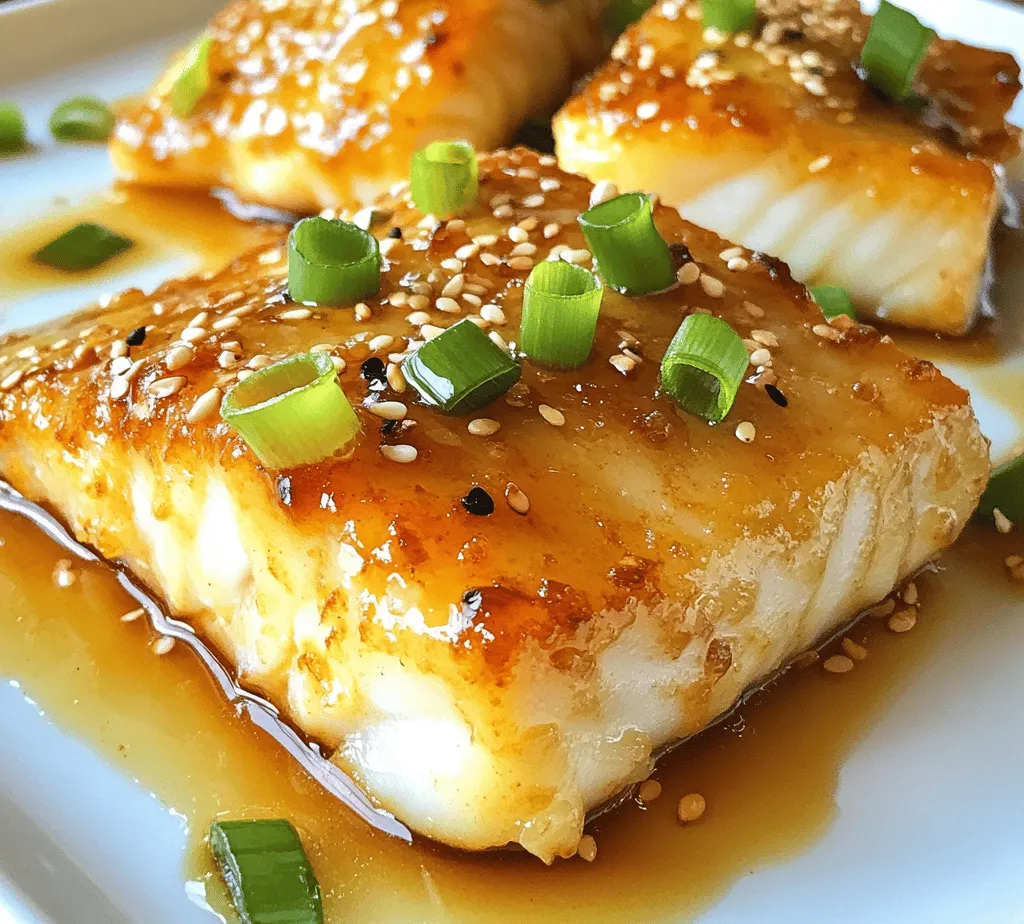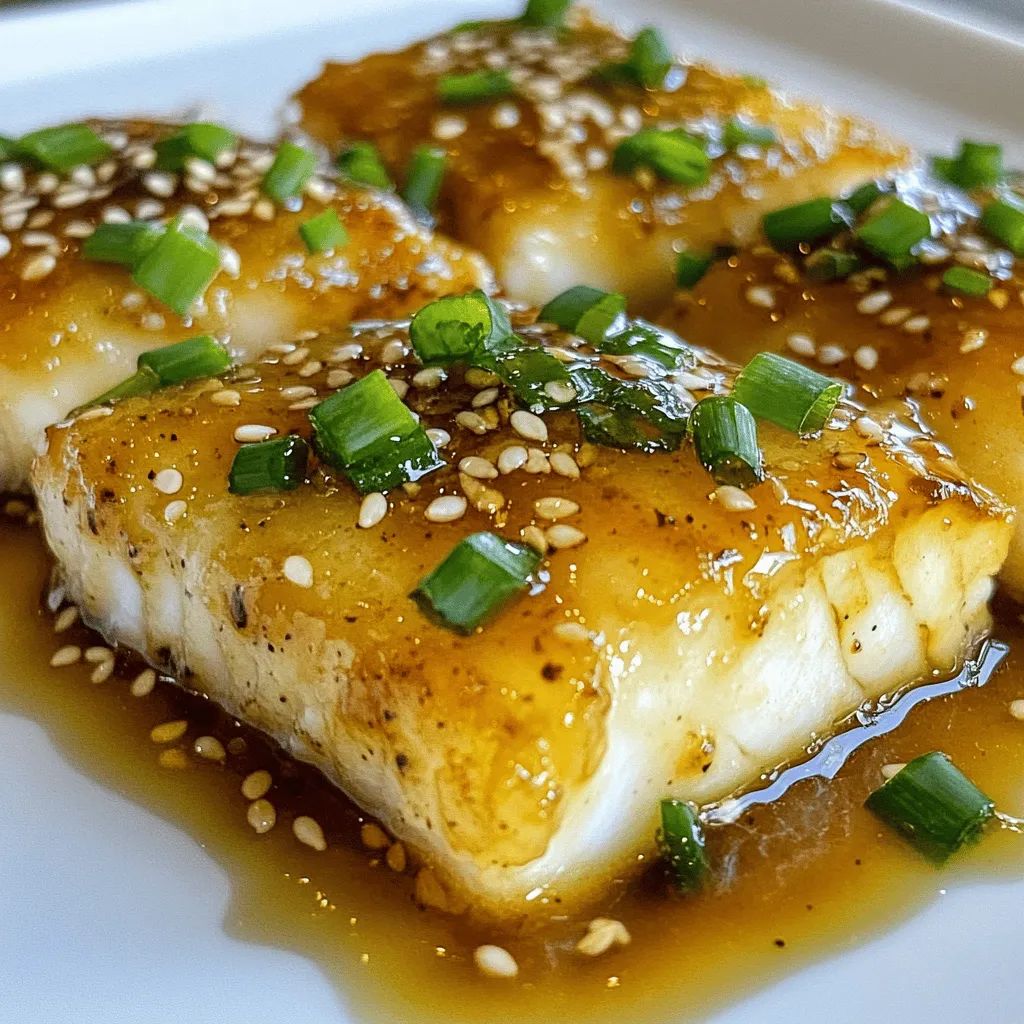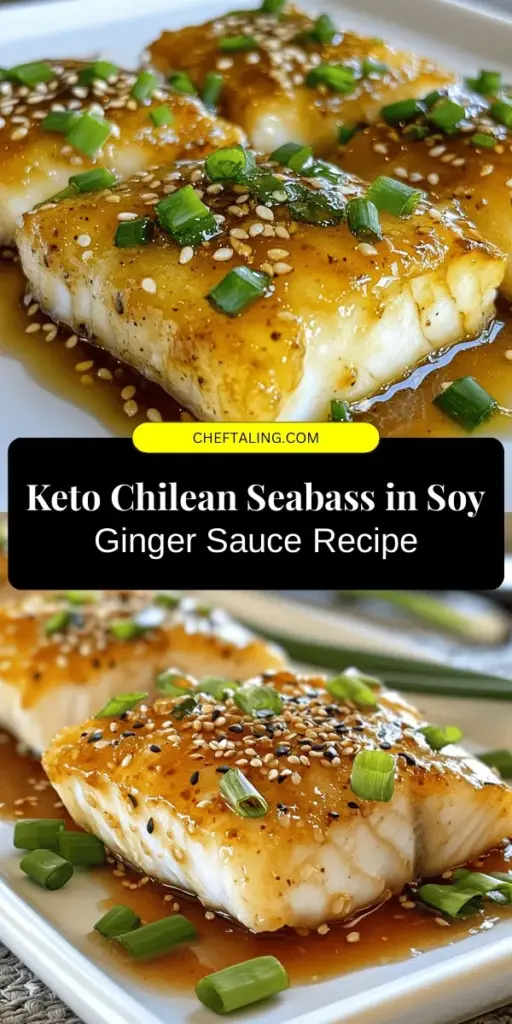Introduction
The Keto diet has surged in popularity in recent years, captivating the attention of health enthusiasts and food lovers alike. This low-carbohydrate, high-fat diet focuses on reducing carbohydrate intake while increasing fat consumption, leading the body into a metabolic state known as ketosis. When in ketosis, the body becomes efficient at burning fat for energy, which can result in weight loss, improved energy levels, and better mental clarity. As more people turn to the Keto lifestyle, the search for delicious recipes that fit within these dietary guidelines intensifies.
One such recipe that combines the principles of the Keto diet with vibrant flavors is the Keto Asian-Inspired Chilean Seabass in Soy Ginger Sauce. This dish showcases the succulent and buttery texture of Chilean seabass, a fish that is not only a fantastic source of protein but also rich in omega-3 fatty acids. These healthy fats are integral to any Keto diet, supporting heart health and reducing inflammation. The dish is further elevated by a savory soy ginger sauce, which infuses the fish with aromatic flavors while remaining compliant with Keto dietary restrictions.
In this article, we will delve into the enticing world of Keto Asian-Inspired Chilean Seabass in Soy Ginger Sauce, exploring its ingredients, nutritional benefits, and cooking techniques. Whether you’re a Keto veteran or just beginning your culinary journey, this recipe is sure to delight your palate while aligning with your dietary goals.
Understanding the Ingredients
Chilean Seabass
Chilean seabass, also known as Patagonian toothfish, is a highly sought-after fish known for its rich, buttery flavor and flaky texture. This fish is not only delicious but also packed with nutrients, making it an excellent choice for those following a Keto diet. Each serving of Chilean seabass is loaded with protein, crucial for muscle maintenance and repair, while being low in carbohydrates—a perfect match for Keto enthusiasts.
Apart from its taste and nutritional value, Chilean seabass is often caught in deep, cold waters, often leading to concerns about sustainability. However, many fisheries now adhere to sustainable fishing practices, helping to ensure that this delicious fish remains available for years to come. When purchasing Chilean seabass, look for certifications from organizations that promote sustainable fishing to make an environmentally conscious choice.
Nutritional Benefits
Incorporating Chilean seabass into your diet offers numerous health benefits. It is an excellent source of protein, providing around 22 grams per 3-ounce serving, which is essential for muscle growth and repair. Additionally, the fish is rich in omega-3 fatty acids, which are known for their anti-inflammatory properties and benefits to heart and brain health. Omega-3s can help reduce the risk of chronic diseases, making this fish a fantastic addition to a balanced diet.
Moreover, Chilean seabass is also a good source of essential vitamins and minerals, including Vitamin B12, selenium, and potassium. Vitamin B12 plays a critical role in maintaining healthy nerve function and red blood cell production, while selenium is an important antioxidant that helps protect cells from damage. Potassium, on the other hand, is vital for muscle function and regulating blood pressure.
Overview of Key Ingredients in the Recipe
The success of the Keto Asian-Inspired Chilean Seabass in Soy Ginger Sauce lies not only in the fish itself but also in the carefully selected supporting ingredients that enhance its flavor profile. Here are some key ingredients that contribute to this dish’s mouthwatering taste:
- Soy Sauce vs. Tamari: Soy sauce is a staple in Asian cuisine, known for its salty, umami flavor. For those following a gluten-free diet, tamari is an excellent alternative. Made from fermented soybeans, tamari has a richer flavor and is often gluten-free, making it a great option for Keto enthusiasts.
- Sesame Oil: This oil is an essential ingredient in Asian cooking, imparting a nutty flavor to dishes. It is also rich in antioxidants and healthy fats, making it a beneficial addition to your Keto meal plan.
- Ginger and Garlic: Both ginger and garlic are integral to the flavor profile of this dish. Ginger adds a warm, spicy kick, while garlic contributes depth and aroma. Beyond their flavors, both ingredients are known for their health benefits, including anti-inflammatory properties and immune system support.
- Erythritol and Stevia: To maintain the sweetness of the dish without introducing unnecessary carbohydrates, we turn to keto-friendly sweeteners such as erythritol and stevia. These natural sweeteners provide a hint of sweetness without the calories or blood sugar spikes associated with traditional sugars.
- Chili Paste: A touch of chili paste adds a layer of heat and complexity to the soy ginger sauce, elevating the overall flavor. It is essential to balance the spice level to suit your personal taste.
- Garnishing Ingredients: The final touches of green onions and sesame seeds not only enhance the visual appeal of the dish but also contribute additional flavor and texture. Green onions offer a mild onion flavor, while sesame seeds add a delightful crunch.
Marinating the Seabass
Importance of Marination in Enhancing Flavor
Marination is a crucial step in preparing the Keto Asian-Inspired Chilean Seabass, as it allows the fish to absorb the flavors of the marinade, resulting in a more flavorful and enjoyable dish. The marinating process not only infuses the fish with savory notes but also helps to tenderize it, ensuring a succulent bite with every forkful.
Step-by-Step Guide to Preparing the Marinade
Creating the marinade for your Chilean seabass is simple and requires just a handful of ingredients. Here’s how to prepare it:
1. Gather the Ingredients: For the marinade, you will need soy sauce or tamari, sesame oil, minced ginger, minced garlic, erythritol or stevia, and chili paste.
2. Mix the Marinade: In a mixing bowl, combine 1/4 cup of soy sauce (or tamari) with 2 tablespoons of sesame oil. Add 2 teaspoons of minced ginger and 2 teaspoons of minced garlic for aromatic depth. To introduce sweetness, add 1-2 teaspoons of erythritol or stevia, adjusting to taste. Finally, mix in 1 tablespoon of chili paste for a spicy kick. Whisk the ingredients together until well combined.
3. Marinate the Fish: Place the Chilean seabass fillets in a resealable plastic bag or shallow dish. Pour the marinade over the fish, ensuring it is evenly coated. Seal the bag or cover the dish and refrigerate for at least 30 minutes, allowing the flavors to meld.
How Each Ingredient Contributes to the Overall Taste
Each component of the marinade plays a vital role in enhancing the flavor of the Chilean seabass:
- Soy Sauce/Tamari: Provides saltiness and umami, which are essential for flavor depth.
- Sesame Oil: Adds a rich, nutty aroma that complements the fish beautifully.
- Ginger and Garlic: Infuse warmth and complexity, elevating the overall taste profile.
- Erythritol/Stevia: Introduces a subtle sweetness that balances the savory elements.
- Chili Paste: Offers heat and complexity, making the dish more exciting.
Tips for Marinating Effectively
To achieve optimal flavor absorption, consider these tips:
- Use Fresh Ingredients: Fresh ginger and garlic will yield the best flavor results.
- Marinate in the Fridge: Always refrigerate while marinating to prevent bacterial growth.
- Avoid Over-Marinating: While marinating is vital, too long can lead to a mushy texture. Aim for 30 minutes to 2 hours, depending on the thickness of the fillets.
Ideal Marination Times for Maximum Flavor Absorption
For Chilean seabass, a marination time of 30 minutes to 2 hours is ideal. This timeframe allows the fish to soak in the marinade without compromising its texture. If you’re short on time, even a quick 15-minute soak can impart some flavor, but longer is better for a well-rounded taste.
Cooking Techniques for Perfect Seabass
Preparing the Skillet: Choosing the Right Cookware
The cooking method you choose can significantly affect the final outcome of your Chilean seabass. A heavy-bottomed skillet, preferably cast iron or stainless steel, is recommended for even heat distribution. These types of cookware retain heat well, ensuring a beautifully seared crust while cooking the fish evenly throughout.
Before cooking, it’s essential to preheat the skillet over medium-high heat. This step is crucial for achieving that coveted golden crust on the fish, enhancing both its appearance and flavor.
Explanation of Cooking Temperatures for Optimal Results
For the perfect cooking temperature, aim for medium-high heat. This allows the fish to sear beautifully while preventing it from becoming dry. Once the skillet is hot, add a small amount of oil (such as avocado oil or additional sesame oil) to prevent sticking.
Carefully place the marinated Chilean seabass fillets in the skillet, ensuring not to overcrowd the pan. Cook for approximately 4-5 minutes on one side until golden brown, then gently flip and cook for an additional 3-4 minutes, or until the fish flakes easily with a fork. The ideal internal temperature for cooked fish is around 145°F (63°C).
By following these steps and techniques, you can create a delightful Keto Asian-Inspired Chilean Seabass in Soy Ginger Sauce that is not only satisfying to the taste buds but also aligns perfectly with your dietary preferences. Stay tuned for the next part of this article, where we will cover the final touches and plating of this exquisite dish.

Understanding Medium-High Heat in Cooking Fish
When it comes to cooking fish like Chilean seabass, medium-high heat is ideal for achieving the perfect texture and flavor. This temperature allows the fish to cook through without drying out or becoming rubbery. When the heat is set correctly, the exterior of the fish sears beautifully, creating a delicious crust while keeping the inside tender and moist. To achieve this, preheat your skillet or pan for a few minutes before adding the fish. It’s essential to know your stovetop, as the actual temperature can vary between different models.
Techniques for Achieving Crispy Skin
To obtain that coveted crispy skin on your Chilean seabass, follow these tips:
1. Pat the Fish Dry: Before cooking, ensure the skin of the fish is completely dry. Use paper towels to pat it down, which helps to remove excess moisture that can prevent crispiness.
2. Use the Right Fat: Choose fats with high smoke points, like avocado oil or ghee, to prevent burning and promote browning.
3. Don’t Crowd the Pan: Cook the fish in batches if necessary. Overcrowding can lead to steaming rather than searing, which inhibits crispiness.
4. Avoid Moving the Fish: Once the fish is placed skin-side down in the pan, resist the urge to move it around. Let it cook undisturbed until it naturally releases from the pan, usually around 4-5 minutes.
Importance of Skin-Side Down Cooking
Starting with the skin-side down is crucial for several reasons. Firstly, it allows the skin to become crispy while the flesh cooks gently, preventing it from becoming overcooked. Secondly, the skin acts as a barrier, protecting the delicate meat from direct heat, thereby ensuring a moist and tender result. This method also allows the flavor from the skin to infuse into the fish, enhancing the overall taste of the dish.
How to Flip Without Breaking the Fillet
Flipping delicate fish fillets can be daunting, but with the right technique, it can be done without breaking them. Here’s how:
1. Use a Thin Spatula: A fish spatula is ideal, as it has a flexible blade that can slide under the fish easily.
2. Wait for the Right Moment: Wait until the edges of the fish begin to look opaque and the skin is golden brown. If the fish is sticking, it’s not ready to flip.
3. Gently Slide Under the Fillet: Carefully slide the spatula under the fillet, ensuring that you are lifting from the center, which provides better support.
4. Flip with Confidence: Once the spatula is securely under the fish, quickly flip it over while keeping the spatula close to the pan to prevent splashing.
Creating the Soy Ginger Sauce
Using the Reserved Marinade: The Benefits of Reusing Ingredients
Utilizing the reserved marinade for your soy ginger sauce not only enhances the flavor but also minimizes waste. The marinade, packed with flavors, contains the essence of the dish and adds depth to the sauce. Be sure to bring it to a boil before using to eliminate any raw fish contamination.
Techniques for Glazing and Spooning Sauce
To glaze your Chilean seabass effectively, follow these steps:
1. Reduce the Marinade: After boiling the reserved marinade, reduce it by simmering until it thickens slightly. This concentration intensifies the flavor.
2. Spoon Over the Fish: Once the fish is nearly done, use a spoon to ladle the thickened sauce over it. This technique allows the flavors to meld while giving a beautiful sheen to the fillet.
3. Baste Frequently: If time allows, baste the fish with the sauce every minute or so for an even coat of flavor.
How to Ensure Even Flavor Distribution
For an evenly flavored dish, ensure the sauce reaches all parts of the fish. By spooning the sauce over the fillet multiple times during cooking and allowing it to simmer gently, the flavors will permeate the fish. Additionally, consider tossing any accompanying vegetables in the sauce to ensure every element of the dish has that delicious flavor profile.
Signs of Doneness in Chilean Seabass
Chilean seabass is known for its rich, buttery texture, which makes it a favorite among seafood lovers. To check for doneness, look for the following signs:
- Flakiness: When the fish is opaque and flakes easily with a fork, it is done. Press gently with the fork to see if it separates easily.
- Internal Temperature: The USDA recommends an internal temperature of 145°F for fish. A kitchen thermometer can ensure accurate cooking.
- Color Change: The flesh should transition from translucent to opaque as it cooks.
Serving Suggestions
Ideal Sides to Complement the Dish
Pairing your Keto Asian-Inspired Chilean Seabass with complementary sides enhances the meal experience. Here are some excellent options:
- Low-Carb Vegetables: Roasted or sautéed vegetables such as broccoli, bok choy, or zucchini offer a nutritious balance and maintain the low-carb profile of the meal.
- Cauliflower Rice: A fantastic alternative to traditional rice, cauliflower rice is easy to prepare. Simply pulse cauliflower florets in a food processor until they resemble rice grains, then sauté in a pan with a bit of olive oil and seasonings of your choice.
Plating Techniques to Enhance Presentation
Presentation can elevate your dish from ordinary to extraordinary. Consider the following plating techniques:
- Layering: Place a scoop of cauliflower rice on the plate, followed by the seabass fillet. Arrange sautéed vegetables artistically around the fish.
- Garnishes: Add fresh herbs like chopped cilantro or sliced green onions for a pop of color and freshness. A sprinkle of sesame seeds can also add texture.
- Drizzling Sauce: Drizzle additional soy ginger sauce around the plate for a professional touch.
Color and Texture Balance with Garnishes
Incorporate contrasting colors and textures to make the dish visually appealing. Bright green vegetables against the golden-brown seabass create a vibrant contrast. Adding a squeeze of lime or lemon can brighten the dish and enhance the flavors, while sliced red chili can introduce a touch of heat and color.
Nutritional Analysis
Breakdown of the Nutritional Value of the Completed Dish
This Keto Asian-Inspired Chilean Seabass is not only delicious but also nutritious. Here’s a typical breakdown per serving:
- Calories: Approximately 400-450 kcal
- Fats: 25-30g (mostly healthy fats from the fish and oils)
- Proteins: 40-45g
- Carbohydrates: Less than 10g
Benefits of Incorporating This Dish into a Keto Diet
Chilean seabass is an excellent source of high-quality protein and omega-3 fatty acids, which are beneficial for heart health. This dish fits perfectly within a keto diet, providing healthy fats while keeping carbohydrates low, making it an excellent option for those looking to maintain or lose weight without sacrificing flavor.
Conclusion
The Keto Asian-Inspired Chilean Seabass in Soy Ginger Sauce offers a delightful blend of flavors and textures that will satisfy your taste buds while adhering to your dietary goals. With its crispy skin, tender meat, and savory sauce, it’s a dish that not only impresses but also nourishes. We encourage you to try making this dish at home, as it is both accessible and rewarding. Plus, don’t forget to explore more keto recipes that promote a balanced diet and enjoyable cooking experiences. The culinary world is rich with possibilities, and each recipe is a new adventure waiting to be savored.


